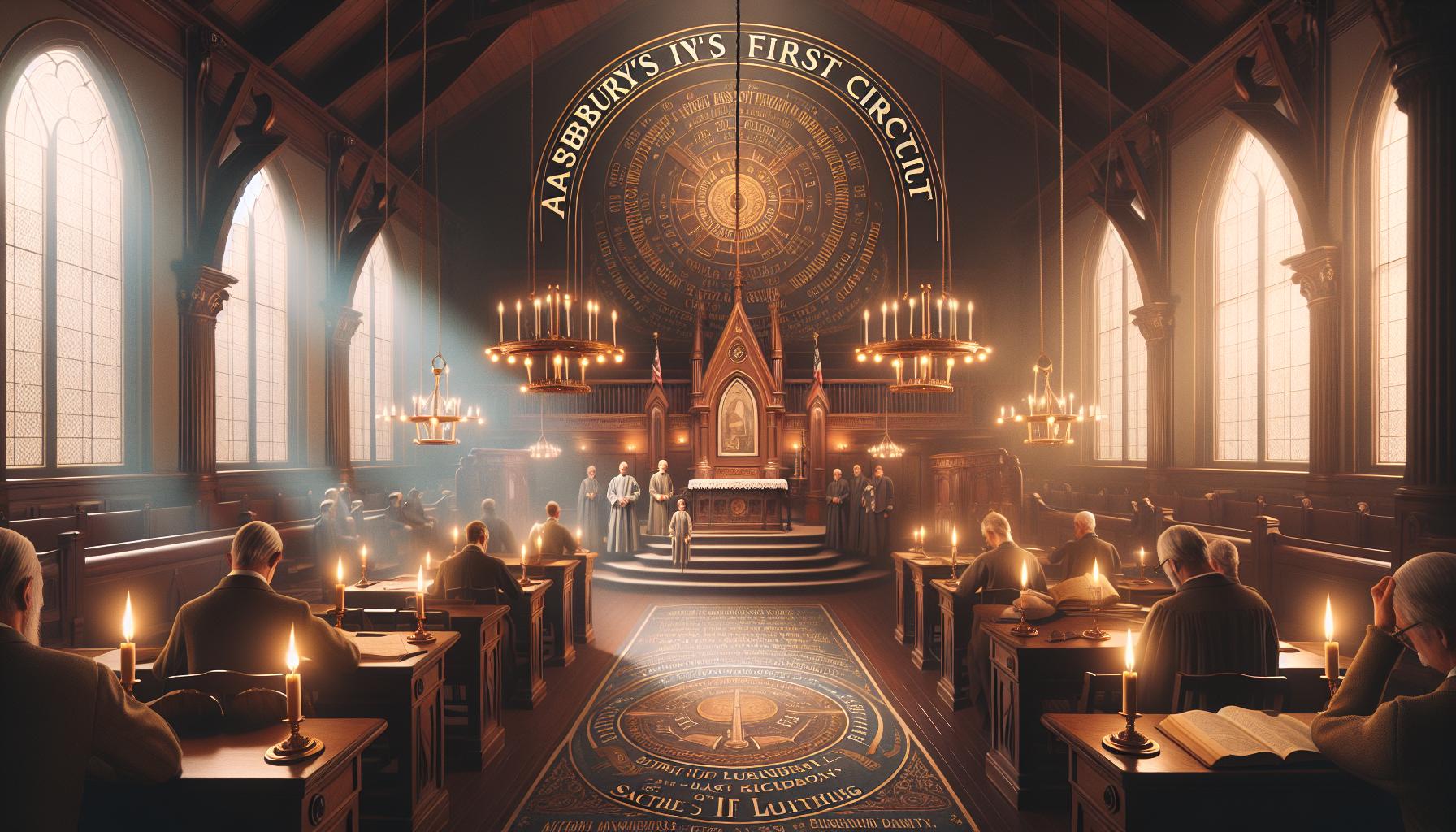What sparked the rapid growth of Methodism in early America? This article delves into the origins of Asbury’s first preaching circuit, a pivotal moment in Methodist history that shaped the movement’s expansion. Understanding this foundation not only illuminates the church’s journey but also resonates with ongoing discussions about religious outreach today.
Tracing the Roots: Understanding Asbury’s Role in Early Methodism
Throughout the late 18th century, a significant transformation was underway in the religious landscape of America, largely due to the fervent efforts of early Methodists. Among the key figures was Francis Asbury, whose influence shaped the direction of Methodism in its formative years. His early preaching circuit was instrumental in establishing the movement, responding to the spiritual needs of a burgeoning society. Understanding Asbury’s role provides valuable insight into the development of Methodism and its lasting impact on American Christianity.
Asbury’s first preaching circuit, established in the United States in 1771, embodied the itinerant nature of early Methodism. This approach, characterized by travel and personal outreach, allowed Asbury to cater to diverse communities, from urban centers to rural villages. By traversing the nascent American frontier, he not only preached the gospel but also organized congregations, laying the foundation for what would become a robust Methodist Church.
The Itinerant Model of Ministry
The itinerant system, where preachers moved from one location to another, was not simply a method of evangelism; it was a proactive response to the spiritual vacuum present at the time. The results of Asbury’s extensive travels are notable. Here are some key outcomes of his ministry:
- Expansion of Membership: Increased numbers of adherents as more people encountered the Methodist message.
- Community Building: Establishment of local congregations that served as hubs of support and fellowship.
- Social Reform: Advocacy for social justice issues that resonated with the growing number of members.
Asbury’s commitment to the itinerant ministry was not without challenges; he faced opposition and hostility. Nevertheless, he persevered, often riding over rough terrain and enduring adverse weather to fulfill his mission. The enduring spirit of his work not only expanded the Methodist movement but also inspired others to continue spreading the message, creating networks of evangelism that would stretch across the entire nation.
Influence on Methodist Doctrine and Practices
Beyond mere church growth, Asbury played a pivotal role in defining Methodist doctrine and practices. His emphasis on personal holiness, social responsibility, and grassroots involvement became hallmarks of the movement. This approach also set the stage for the future developments within Methodism, leading to diverse expressions of faith that would mark the denomination in the centuries to come.
| Key Aspects of Asbury’s Influence | Description |
|---|---|
| Personal Holiness | Emphasis on individual spiritual growth and discipline |
| Social Responsibility | Encouragement of outreach and support for the marginalized |
| Decentralized Leadership | Empowering local church leaders to guide their communities |
To fully appreciate the impact of Asbury’s first preaching circuit and the broader scope of Methodist history, one must recognize the interplay between his pioneering efforts and the cultural currents of the time. Asbury’s legacy serves as a powerful reminder of how one dedicated individual can galvanize a faith movement, shaping the spiritual landscape for generations to come.
The Historical Context of Preaching Circuits in the 18th Century
During the 18th century, the rise of itinerant preaching marked a transformative era in religious practice, particularly within the Methodist movement. At the heart of this evolution was the concept of preaching circuits, which involved itinerant ministers traveling designated routes to reach congregants spread across vast distances. This practice was essential to the spread of Methodism, especially in the United States, where the lack of established churches and clergy made regular religious services sporadic at best.
The establishment of these circuits allowed for a structured yet flexible system of pastoral care, accommodating the needs of growing populations in newly settled areas. John Wesley, the founder of Methodism, was instrumental in developing this model, emphasizing the necessity of adaptability in ministry to cater to various communities. The impacts of preaching circuits can be seen in several key aspects:
- Increased Accessibility: Itinerant preachers made church services accessible to those in remote locales, facilitating spiritual engagement where it previously might not have existed.
- Community Building: Regular visits fostered a sense of community, as these itinerants often preached in homes, fields, and public spaces, thereby reinforcing social bonds and collective identification.
- Lay Leadership Development: Preaching circuits empowered local lay leaders, fostering grassroots involvement in church activities and creating a more dynamic religious atmosphere.
The Role of Bishop Asbury in Shaping Preaching Circuits
Bishop Francis Asbury, one of the first leaders of American Methodism, played a pivotal role in the formation and expansion of these preaching circuits. Appointed as the first Methodist bishop in America in 1784, he traveled extensively—often covering as many as 6,000 miles each year—establishing numerous circuits across the burgeoning nation.
The circuits not only addressed the spiritual needs of settler populations but also helped shape the cultural landscape of early American society. Asbury’s method of circuit-riding emphasized the importance of personal connection and engagement, often integrating local customs and needs into the sermons and practices of Methodism.
| Key Aspects of Preaching Circuits | Impact |
|---|---|
| Regular Visits by Itinerant Preachers | Enabled ongoing spiritual education and growth. |
| Grassroots Community Engagement | Fostered individual and collective faith development. |
| Adaptation of Methodist Practices | Created a unique blend of Protestant traditions suitable for local contexts. |
In this framework, one can understand “Where Was Asbury’s First Preaching Circuit: Methodist History Explored” not merely as a geographical inquiry but as an essential component in the broader narrative of American religious history. The establishment of these circuits laid the groundwork for a resilient and adaptive Methodist movement that continues to thrive today. By reflecting on the past, current congregations can draw lessons in community engagement and adaptability from the pioneering spirit of those early itinerant preachers.
Key Locations Along Asbury’s First Circuit: A Journey Through Methodism
The roots of Methodism can be traced through a series of significant locations that were part of Asbury’s pioneering preaching circuit, a journey that laid the foundation for one of the most influential movements in American religious history. These key sites not only reflect the tenacity of early Methodist leaders but also their dedication to spreading the message of faith amidst the evolving American landscape. Exploring these locations provides a glimpse into the beginnings of Methodism and how it has shaped modern spirituality.
Legacy of Key Locations
The first preaching circuit, established by Bishop Francis Asbury, included various towns and communities that became pivotal to the spread of Methodism. Below are some notable locations along Asbury’s circuit:
- Philadelphia, Pennsylvania – Often considered the cradle of American Methodism, this city served as a significant starting point where Asbury held many early meetings and established a network of local preachers.
- Baltimore, Maryland – Asbury’s frequent visits to Baltimore helped cement its role as an important hub for Methodist activity, featuring annual conferences and the commissioning of many early missionaries.
- Delaware – The state played a crucial role in the growth of the Methodist movement, with numerous congregations emerging as a direct result of Asbury’s preaching efforts across the area.
- New Jersey – With its diverse communities, New Jersey became a site of significant Methodist growth, where Asbury’s dynamic sermons inspired many to join the faith.
Impactful Venues
Each location not only served as a stop for Asbury but also contributed uniquely to the movement’s development. Churches and public halls in these areas often hosted large gatherings, fostering community support and spiritual growth. A few impactful venues include:
| Location | Significance |
|---|---|
| St. George’s Church, Philadelphia | Site of early meetings and the establishment of the first Methodist society in America. |
| Mount Olivet Church, Baltimore | Significant church where many early Methodists received training and support for evangelical missions. |
| Old Swedes Church, Wilmington | A gathering point for early Methodists in Delaware, supporting local outreach efforts. |
Visiting these key locations not only offers a historical perspective on “Where Was Asbury’s First Preaching Circuit: Methodist History Explored” but also provides spiritual enrichment. Many of these sites still welcome visitors, offering opportunities for reflection and connection with the roots of the faith. Engaging with these significant landmarks allows congregants and historians alike to appreciate the legacy of Francis Asbury and the resilience of early Methodists in their commitment to spreading the word.
The Impact of Circuit Riders on Methodist Growth and Community Life
The story of Methodist expansion is closely intertwined with the dedication and tireless work of circuit riders. These ordained ministers traveled extensively, often in harsh conditions, to share their faith and services with communities often neglected by other religious leaders. Their journeys significantly contributed to the growth of Methodism in America, marking a transformative era that made Methodism a central thread in the fabric of early American society.
Role and Activities of Circuit Riders
Circuit riders were crucial in establishing the first Methodist congregations across vast, rural landscapes. They were typically assigned to a geographical “circuit,” which could cover dozens of miles, requiring them to visit multiple communities regularly. The impact of these rides was profound, as they introduced new church services, established Sunday schools, and created a network of believers. Their efforts fostered a sense of community among attendees, often leading to the development of local society groups. Key activities included:
- Preaching in homes, schools, or public squares, where formal church buildings were often absent.
- Baptizing new members and performing marriages, thus providing essential spiritual services to remote communities.
- Organizing prayer meetings and social gatherings, which helped nurture faith and unity among disparate individuals.
- Creating a sense of belonging by establishing class meetings where community members could gather for discussion and support.
The Significance of Asbury’s First Preaching Circuit
One pivotal moment in Methodism’s history can be traced back to “Where Was Asbury’s First Preaching Circuit: Methodist History Explored.” This first circuit established by Francis Asbury laid the groundwork for what would become a profoundly influential ministry model. The introduction of this new preaching methodology was crucial for reaching distant frontiers at a time when communication options were limited, allowing the church to grow exponentially.
This circuit not only addressed the spiritual needs of isolated populations but also contributed to their social improvement. Circuit riders often served as catalysts for community development, promoting education, literacy, and public morality. They played a role in social reforms, advocating against slavery and encouraging temperance, thus helping shape the moral compass of their communities.
| Circuit Rider Contributions | Impact on Communities |
|---|---|
| Regular preaching and worship services | Fostering spiritual growth and community cohesion |
| Establishing educational programs | Improving literacy rates and educational access |
| Promoting social justice issues | Encouraging moral values and charitable actions |
In summary, the legacy of circuit riders is marked not only by the growth of the Methodist Church but also by their significant contributions to shaping social and community life in early America. These devoted individuals brought faith, hope, and unity to some of the nation’s most underserved areas, forever altering the landscape of American spirituality and community.
Learning from Asbury: Lessons in Preaching and Pastoral Leadership
The early days of Methodism are rich with insights into effective preaching and pastoral leadership, exemplified by the experiences from Asbury’s first preaching circuit. This formative period shaped the methodologies and spiritual approaches that many pastoral leaders continue to embrace today. By examining the historical backdrop and practices within the Methodist movement, contemporary leaders can glean valuable lessons to enhance their own ministries.
Emphasis on Relationship Building
One of the primary takeaways from Asbury’s mission is the importance of establishing strong relationships within communities. During his travels, Asbury focused on connecting not just with individuals, but with entire families and communities. This holistic approach ensured that the message was relevant and resonated with the congregants. For current pastors and leaders, understanding the context of their communities enhances their ability to preach effectively. Here are some key practices to consider:
- Engage Regularly: Attend community events and participate in local traditions to build rapport.
- Listen Actively: Encourage feedback during sermons and discussions to understand congregational needs.
- Foster Small Groups: Create opportunities for intimate gatherings where deeper relationships can form.
Adaptability in Preaching
Asbury’s ability to adapt his preaching style according to the audience’s needs was instrumental to his success. Each context offered unique challenges and opportunities, compelling him to be flexible with his messages. This adaptability is a crucial skill for today’s leaders in ministry. Leaders should assess their congregations’ backgrounds, preferences, and contemporary issues to craft relevant messages. Here are practical tips to enhance adaptability in preaching:
- Know Your Audience: Conduct surveys or informal conversations to gauge the spiritual and emotional state of your audience.
- Utilize Storytelling: Incorporate relatable narratives that resonate with listeners’ everyday experiences.
- Leverage Current Events: Tie in topical issues or local news stories to connect with congregants on a deeper level.
Collaboration and Empowerment
Another important lesson is Asbury’s commitment to collaboration. He understood that empowering lay leaders and creating a robust network of volunteers significantly expanded the outreach of the Methodist movement. Modern-day pastoral leadership can benefit greatly from this collaborative spirit. By fostering a culture of teamwork and inclusivity, churches can thrive. Consider these actionable steps:
- Encourage Lay Leadership: Identify and nurture potential leaders within the congregation.
- Create Task Forces: Form teams focused on specific initiatives, allowing you to delegate responsibilities effectively.
- Provide Training: Equip lay leaders with the necessary resources and training to lead efficiently.
Understanding the historical context and practical applications of Asbury’s first preaching circuit, we can cultivate a style of pastoral leadership that breathes life into congregations, making faith a lived experience rather than just a belief. These enduring principles of relationship building, adaptability, and collaboration remain invaluable to anyone seeking to lead effectively in today’s multifaceted spiritual landscape.
The Legacy of Asbury’s Circuit: How It Shaped Methodism Today
The influence of Asbury’s circuit on Methodism is a testament to the power of grassroots movements in shaping religious traditions. Asbury, known for his relentless travels and passionate preaching, established one of the earliest circuits in American Methodism, which not only spread the Gospel but also laid the groundwork for a distinct Methodist identity. This framework endured long after his time, significantly impacting the development of both the church and its community-focused mission.
The Framework of Methodism
Asbury’s first preaching circuit was designed to adapt to the needs of diverse communities, emphasizing accessibility and personal connection. This approach revolutionized how religious services were conducted and fostered a spirit of congregational participation. The key features of Asbury’s model included:
- Lay Leadership: Empowering local members to lead and serve.
- Mobility: Preachers moving between communities to meet spiritual needs.
- Accountability: Emphasizing accountability among clergy and laity.
- Mission Focus: Prioritizing outreach and service as core tenets of faith.
These principles remain integral to the Methodist Church today, emphasizing the organization as a “connectional” church. This means that local congregations are interconnected, sharing resources and supporting one another in outreach efforts. Asbury’s vision of community-driven faith helps inform contemporary Methodism’s commitment to social justice and service in the world.
Continuing Influence in Modern Methodism
The legacy of Asbury is also evident in the continued emphasis on itinerant preaching. Much like Asbury himself, today’s Methodist ministers often traverse various regions, reaching out to underserved areas and ensuring the gospel message is accessible to all. This ongoing practice is an essential part of the church’s philosophy, reflecting its origins in Asbury’s first preaching circuit.
A prime example of this enduring impact can be seen in the structure and outreach efforts of modern Methodist churches, where many still adopt the circuit model, allowing for flexible ministry in response to community needs.
| Asbury’s Principles | Modern Application |
|---|---|
| Lay Leadership | Encouraging local members to engage in leadership roles within services. |
| Mobility | Ministers serve in multiple locations, expanding reach and connection. |
| Accountability | Regular community meetings foster transparency and collective decision-making. |
| Mission Focus | Active involvement in social justice initiatives and community service. |
Through these practices, today’s Methodists not only honor the legacy of Asbury but also adapt his visionary approach to meet the challenges of a contemporary world. The profound connection forged between faith and action, as established in Asbury’s circuit, continues to inspire and shape the way Methodism engages with broader societal issues, ensuring that the movement remains vibrant and relevant.
Embracing Diversity: Methodism’s Evolution Beyond Asbury’s Journey
Throughout history, Methodism has demonstrated an exceptional ability to adapt and grow, reflecting the rich tapestry of human experience within its teachings. One of the significant turning points in this evolution can be traced back to the early preaching circuits established by John Asbury, whose journeys were pivotal not only in spreading Methodism but in laying the foundational principles of inclusivity and diversity within the church. Asbury’s efforts represent a mere glimpse of the broader transformation that would follow, shaping a faith that embraces varying cultural, racial, and socioeconomic backgrounds.
The Impact of Early Methodism on Social Structure
One of the notable aspects of Methodism’s journey is its grassroots nature. Originating from a movement that valued personal relationships and community action, early Methodism broke social barriers. Diversity in its congregations became a hallmark as Asbury and his contemporaries traveled extensively across the American frontier. This engagement with a myriad of communities not only enriched the church but also allowed for a more profound understanding of social injustices. The movement encouraged members to advocate for the marginalized while actively addressing issues such as slavery and poverty.
Key initiatives that emerged from these early circuits include:
- Formation of Multicultural Congregations: Local congregations often reflected the diverse populations of their regions, promoting a sense of unity and mutual respect.
- Advocacy for Education: Methodists established schools across varied communities, emphasizing education as a cornerstone for social mobility and equality.
- Social Justice Movements: The church became a platform for various social movements, championing the rights of the oppressed and promoting humanitarian efforts.
Innovative Approaches to Ministry
Methodism’s embrace of diversity was further enhanced by innovative approaches to ministry that emphasized accessibility. The church’s leadership recognized the need for diverse ministerial representatives who could relate to and resonate with various groups. This shift led to the inclusion of women and people of color in leadership roles, constantly redefining the church’s identity.
The table below captures some of the pivotal changes and milestones related to diversity within Methodism since Asbury’s time:
| Milestone | Description | Year |
|---|---|---|
| Establishment of African American Congregations | Recognition of the need for separate congregations to serve the Black community, emphasizing the importance of tailored spiritual guidance. | 1787 |
| Women’s Leadership Roles | Beginning of women’s involvement in church leadership, marking the shift towards inclusiveness. | 19th Century |
| United Methodist Church Formation | Merging of several denominations that promoted inclusivity and equality in church practices. | 1968 |
Empowered by these foundational principles, the Methodist Church has continued to evolve, fostering environments where diverse voices can contribute to the church’s mission. This journey of embracing a variety of perspectives remains integral to its identity, reflecting a commitment to unity in diversity that resonates deeply with both historical context and contemporary society.
Practical Insights for Today’s Preachers Inspired by Asbury’s Mission
The early preaching circuits of the Methodist movement are not just historical footnotes; they provide a rich source of inspiration and practical lessons for contemporary preachers. Asbury’s first preaching circuit exemplifies the power of connection, community, and adaptability, which remain crucial in today’s fast-paced, ever-changing world. By examining these foundational elements of the circuit, modern preachers can enrich their own ministries and foster deeper engagement within their communities.
Embrace Community Engagement
In the traditional circuits established by Asbury, the preacher was not merely a lecturer but a community figure deeply connected to the lives of the congregants. This connection made preaching relevant and transformative. To emulate this today, consider the following methods:
- Host Local Gatherings: Regular meetings in homes or community centers can foster relationships that deepen trust and understanding.
- Incorporate Local Issues: Tailoring sermons to address pertinent community challenges can bridge the gap between the pulpit and real life.
- Encourage Testimonials: Allow congregants to share their stories and experiences, highlighting personal faith journeys and communal support.
Adaptability in Outreach
Asbury’s circuits were marked by their flexibility in reaching diverse populations. Modern preachers can learn from this model by adopting a multi-faceted approach to outreach:
- Utilize Social Media: Engage with younger demographics and unreachable audiences by sharing messages, events, and discussions online.
- Develop Diverse Ministry Styles: Experiment with different worship formats, from traditional services to contemporary gatherings, to appeal to varied tastes.
- Foster Intergenerational Connections: Create programs that bring together different age groups, allowing for mentorship and mutual growth.
The Importance of Collaboration
Collaboration was a cornerstone of Asbury’s first preaching circuit, allowing for resource sharing among ministers and communities. Nowadays, leveraging collaboration can significantly enhance a ministry’s impact:
| Collaboration Strategy | Benefit |
|---|---|
| Partnering with Local Organizations | Wider reach and shared resources for community service. |
| Joint Worship Services | Encourages unity and allows for diverse expressions of faith. |
| Mentorship Programs | Strengthens leadership development and congregational growth. |
The legacy of Asbury’s first preaching circuit offers valuable insights into how preachers today can foster vibrant, connected, and adaptable ministries. By embracing community engagement, adapting outreach strategies, and collaborating with local organizations, contemporary preachers can ignite spiritual growth and resilience in their congregations.
Q&A
Where Was Asbury’s First Preaching Circuit: Methodist History Explored?
Asbury’s first preaching circuit was primarily located in the Mid-Atlantic region, including parts of New York and New Jersey. This circuit was instrumental in establishing early Methodist communities.
John Wesley, the founder of Methodism, sent circuit riders to America, and Francis Asbury became a key figure in leading these efforts. His journey significantly shaped Methodist history, allowing it to flourish across a diverse landscape. For a deeper understanding, consider visiting our section on Methodist history.
What is a preaching circuit in Methodist tradition?
A preaching circuit refers to a designated area where a circuit rider—an appointed pastor—travels to preach and minister to congregations. This structure was vital for early Methodism.
The concept allowed Methodist churches to thrive, especially in areas with scarce ministers. By organizing into circuits, Methodists could ensure regular preaching and community support, aligning with their mission of spreading the Gospel. This method remains relevant in many communities today.
Why does Asbury’s first preaching circuit matter?
Asbury’s first preaching circuit is significant because it laid the groundwork for the rapid growth of Methodism in the United States. It exemplifies the early church’s commitment to evangelism.
This circuit facilitated connections among scattered Methodists, providing a framework that allowed for communal worship and leadership training. Understanding this history helps contemporary Methodists appreciate their roots and the challenges their forebearers faced.
Can I visit sites related to Asbury’s first preaching circuit?
Yes, many historical sites related to Asbury’s first preaching circuit can be visited, particularly in New Jersey and New York. Several areas celebrate the Methodist heritage.
These sites often include churches, museums, and interpretative centers that provide insights into Asbury’s life and work. Visiting these places can deepen your understanding of Methodist history and the broader impact of early American religious movements.
How did Francis Asbury influence Methodist practices?
Francis Asbury greatly influenced Methodist practices by promoting itinerant ministry and establishing lay leadership, which became central to Methodist governance. He emphasized accessibility and community.
His approach allowed Methodism to spread quickly and effectively across America, often in rural and underserved areas. Asbury’s legacy lives on in current practices where laypeople often lead community worship and service initiatives.
What challenges did Asbury face in establishing the preaching circuit?
Asbury faced numerous challenges, including limited resources, geographical obstacles, and hostility from established churches. These hurdles tested his resolve and commitment to spreading Methodism.
Despite these challenges, his determination and innovative strategies helped to overcome adversity. Understanding these historical obstacles reveals how resilience and faith can shape communities, an important lesson for contemporary ministries.
In Conclusion
In exploring Asbury’s first preaching circuit, we uncover not only the historical roots of the Methodist movement but also the enduring principles that guide its mission today. Asbury’s commitment to spreading the gospel across diverse communities laid a foundation for a tradition steeped in service, evangelism, and community engagement.
Reflecting on these early journeys, we see the importance of connection—both with God and among believers. The circuit riders exemplified a profound dedication to pastoral care, embodying a spirit of inclusivity and outreach that remains vital for contemporary ministry. The lessons drawn from their journeys challenge us to think about our own roles in the body of Christ, encouraging active participation in our churches and neighborhoods.
As we conclude this exploration of Methodist history, we invite you to delve deeper into this rich heritage. Engage with the stories of figures like Asbury, reflect on their relevance today, and consider how you might contribute to the ongoing mission of faith and service. Let this journey inspire new conversations and actions within your community as you embrace the call to preach, serve, and minister across all boundaries.




